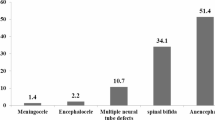Abstract
Background
Neural tube defects (NTDs) and birth defects overall are more likely to occur among maternal compared to paternal relatives in two generations (uncles/aunts and first cousins) of Irish families where an individual has been born with an NTD.
Aims
The aim of this study was to determine if the matrilineal excess persisted into the third generation.
Methods
First cousins were interviewed about their pregnancy outcomes and their offsprings’ health.
Results
Maternal first cousins once removed (FCOR) were more likely to have birth defects than paternal FCOR: 6.7 versus 3.5% (adjusted odds ratio 1.49, 95% CI 0.57, 3.89). No NTDs occurred. Folic acid supplementation significantly reduced the risk of birth defects (P = 0.04).
Conclusions
This study demonstrates an excess of birth defects among maternal relatives in three consecutive generations of NTD families, and supports the hypothesis that an underlying mechanism links distant maternal relatives in at least some NTD families.


Similar content being viewed by others
References
Byrne J (2008) Birth defects in uncles and aunts from Irish families with neural tube defects. Birth Defects Res A Clin Mol Teratol 82(1):8–15
Byrne J (2010) Birth defects among maternal first cousins in Irish families with a neural tube defect. Ir J Med Sci 179:375–380
Deak KL, Siegel DG, George TM et al (2008) Further evidence for a maternal genetic effect and a sex-influenced effect contributing to risk for human neural tube defects. Birth Defects Res A Clin Mol Teratol 82(10):662–669
Hall JG, Friedman JM, Kenna BA et al (1988) Clinical, genetic, and epidemiological factors in neural tube defects. Am J Hum Genet 43(6):827–837
Khoury MJ, Erickson JD, James LM (1982) Etiologic heterogeneity of neural tube defects. II. Clues from family studies. Am J Hum Genet 34(6):980–987
Fraser FCCA, Hanson C (1982) Increased frequency of neural tube defects in sibs of children with other malformations. Lancet 17:144–145
Connor JM, Conner AN, Connor RA et al (1987) Genetic aspects of early childhood scoliosis. Am J Med Genet 27(2):419–424
Elwood JM, Little J, Elwood JH (1992) Epidemiology and control of neural tube defects. Oxford University Press, New York
Byrne J, Carolan S (2006) Adverse reproductive outcomes among pregnancies of aunts and (spouses of) uncles in Irish families with neural tube defects. Am J Med Genet A 140(1):52–61
Byrne J (2010) Periconceptional folic acid prevents miscarriage in Irish families with neural tube defects. Ir J Med Sci (accepted)
Hunter AG (1984) Neural tube defects in Eastern Ontario and Western Quebec: demography and family data. Am J Med Genet 19(1):45–63
Chatkupt S, Skurnick JH, Jaggi M et al (1994) Study of genetics, epidemiology, and vitamin usage in familial spina bifida in the United States in the 1990s. Neurology 44(1):65–70
Botto LD, Lisi A, Robert-Gnansia E et al (2005) International retrospective cohort study of neural tube defects in relation to folic acid recommendations: are the recommendations working? BMJ 330(7491):571
Mefford HC, Sharp AJ, Baker C et al (2008) Recurrent rearrangements of chromosome 1q21.1 and variable pediatric phenotypes. N Engl J Med 359(16):1685–1699
Acknowledgments
Partial support for this study was provided by the Joseph E. and Marjorie B. Jones Foundation and the Friends of the Boyne Research Institute. I am grateful to the families who participated in this study, and to Susan Carolan, Dorothy Collins, Yvonne Byrne, Suzanne Markey, Mark Harmon, David Carroll, Rebecca Lawler and Sharon McGinty for expert technical assistance.
Author information
Authors and Affiliations
Corresponding author
Rights and permissions
About this article
Cite this article
Byrne, J. Three generations of matrilineal excess of birth defects in Irish families with neural tube defects. Ir J Med Sci 180, 69–72 (2011). https://doi.org/10.1007/s11845-010-0632-x
Received:
Accepted:
Published:
Issue Date:
DOI: https://doi.org/10.1007/s11845-010-0632-x




